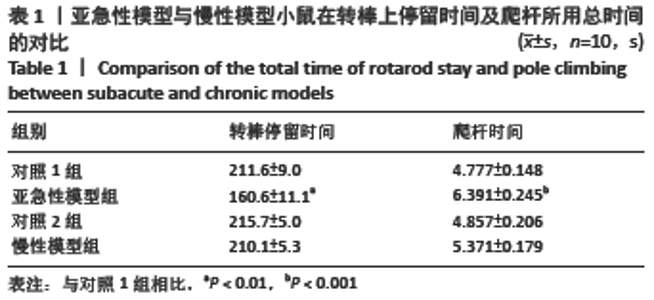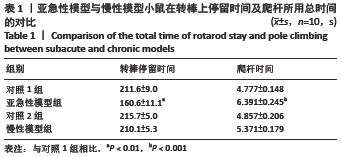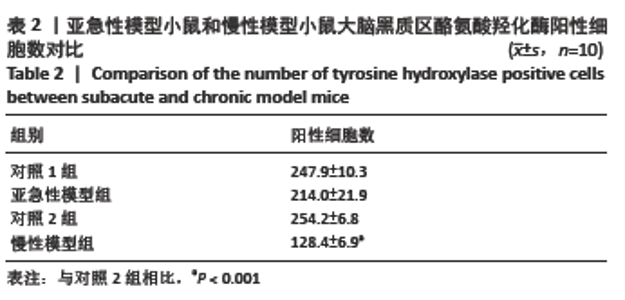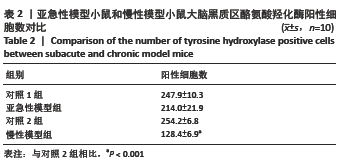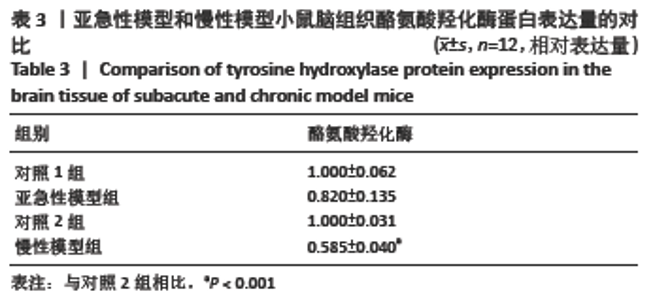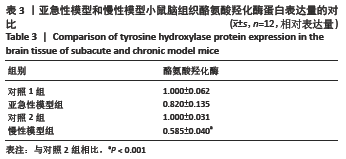[1] REICH SG, SAVITT JM. Parkinson’s Disease. Med Clin North Am. 2019; 103(issue):337-350.
[2] DENG H, WANG P, JANKOVIC J. The genetics of Parkinson disease.Ageing Res Rev. 2018;42:72-85.
[3] ANTONY P, DIEDERICH N, BALLING R. Parkinson’s disease mouse models in translational research. Mamm Genome. 2011;22(7-8):401-419.
[4] RAZA C, ANJUM R, SHAKEEL NUA. Parkinson’s disease: Mechanisms, translational models and management strategies. Life Sci. 2019; 226(issue):77-90.
[5] ARMSTRONG MJ, OKUN MS. Diagnosis and Treatment of Parkinson Disease: A Review. JAMA. 2020;323(issue):548-560.
[6] TAGUCHI T, IKUNO M, YAMAKADO H, et al. Animal Model for Prodromal Parkinson’s Disease. Int J Mol Sci. 2020;21(6):1961.
[7] KIN K, YASUHARA T, KAMEDA M, et al. Animal Models for Parkinson’s Disease Research: Trends in the 2000s. Int J Mol Sci. 2019;20(21):5402.
[8] MORIN N, JOURDAIN V, DI PAOLO T. Modeling dyskinesia in animal models of Parkinson disease. Exp Neurol. 2014;256:105-116.
[9] SUN MF, ZHU YL, ZHOU ZL, et al. Neuroprotective effects of fecal microbiota transplantation on MPTP-induced Parkinson’s disease mice: Gut microbiota, glial reaction and TLR4/TNF-α signaling pathway. Brain Behav Immun. 2018;70:48-60.
[10] XIE W, GAO J, JIANG R, et al. Twice subacute MPTP administrations induced time-dependent dopaminergic neurodegeneration and inflammation in midbrain and ileum, as well as gut microbiota disorders in PD mice. Neurotoxicology. 2020;76:200-212.
[11] LIU Y, YUE F, TANG R, et al. Progressive loss of striatal dopamine terminals in MPTP-induced acute parkinsonism in cynomolgus monkeys using vesicular monoamine transporter type 2 PET imaging ([(18)F]AV-133). Neurosci Bull. 2014;30(3):409-416.
[12] WANG L, ZHAI YQ, XU LL, et al. Metabolic inflammation exacerbates dopaminergic neuronal degeneration in response to acute MPTP challenge in type 2 diabetes mice. Exp Neurol. 2014;251:22-29.
[13] MASILAMONI GJ, SMITH Y. Chronic MPTP administration regimen in monkeys: a model of dopaminergic and non-dopaminergic cell loss in Parkinson’s disease. J Neural Transm (Vienna). 2018;125(3):337-363.
[14] HE X, YANG S, ZHANG R, et al. Smilagenin Protects Dopaminergic Neurons in Chronic MPTP/Probenecid-Lesioned Parkinson’s Disease Models. Front Cell Neurosci. 2019;13:18.
[15] SCHOBER A. 2004. Classic toxin-induced animal models of Parkinson’s disease: 6-OHDA and MPTP. Cell Tissue Res. 2004;318(1):215-224.
[16] von Bohlen Und Halbach O.Modeling neurodegenerative diseases in vivo review. Neurodegener Dis. 2005;2(6):313-320.
[17] PRZEDBORSKI S. The parkinsonian toxin 1‐methyl‐4‐phenyl‐1,2,3,6‐tetrahydropyridine (MPTP): a technical review of its utility and safety. J Neurochem. 2001;76(5):1265-1274.
[18] MAIN B, ZHANG M, BRODY K, et al. Type-1 interferons contribute to the neuroinflammatory response and disease progression of the MPTP mouse model of Parkinson’s disease. Glia.2016;64(issue):1590-1604.
[19] VITALI R, CLARKE S. Improved rotorod performance and hyperactivity in mice deficient in a protein repair methyltransferase. Behav Brain Res. 2004;153(1):129-141.
[20] ROZAS G, LABANDEIRA GARCÍA JL. Drug-free evaluation of rat models of parkinsonism and nigral grafts using a new automated rotarod test. Brain Res. 1997;749(2):188-199.
[21] OGAWA N, HIROSE Y, OHARA S, et al. A simple quantitative bradykinesia test in MPTP-treated mice. Res Commun Chem Pathol Pharmacol. 1985;50(3):435-441.
[22] LUCHTMAN DW, SHAO D, SONG C. Behavior, neurotransmitters and inflammation in three regimens of the MPTP mouse model of Parkinson’s disease. Physiol Behav. 2009;98(1-2):130-138.
[23] PAXINOS G, FRANKLIN K BJ. Paxinos and Franklin’s the Mouse Brain in Stereotaxic Coordinates. Amsterdam : Boston : Elsevier/Academic Press.2013.
[24] KIM A, KOZINA E, KOLACHEV AA, et al.Cooperative synthesis of dopamine by striatal non-dopaminergic neurons as a mechanism of neuroplasticity at parkinsonism. Parkinsonism & Related Disorders. 2018;46(issue):e26-e27.
[25] DE BIE R, CLARKE C, ESPAY A, et al. 2020. Initiation of pharmacological therapy in Parkinson’s disease: when, why, and how. Lancet Neurol. 2020;19(5):452-461.
[26] SIMOLA N, PINNA A, FENU S. Pharmacological therapy of Parkinson’s disease: current options and new avenues. Recent Pat CNS Drug Discov. 2010;5(3):221-238.
[27] RAI SN, SINGH P, VARSHNEY R, et al. Promising drug targets and associated therapeutic interventions in Parkinson’s disease. Neural Regen Res. 2021;16(9):1730-1739.
[28] JACKSON-LEWIS V, PRZEDBORSKI S. Protocol for the MPTP mouse model of Parkinson’s disease. Nat Protoc. 2007;2(issue):141-151.
[29] ROUSSELET E, JOUBERT C, CALLEBERT J, et al. Behavioral changes are not directly related to striatal monoamine levels, number of nigral neurons, or dose of parkinsonian toxin MPTP in mice. Neurobiol Dis. 2003;14(2):218-228.
[30] BEZARD E, GROSS C, BROTCHIE J. Presymptomatic compensation in Parkinson’s disease is not dopamine-mediated. Trends Neurosci. 2003;26(4):215-221.
[31] ZIGMOND M, ABERCROMBIE E, BERGER T, et al. Compensations after lesions of central dopaminergic neurons: some clinical and basic implications. Trends Neurosci. 1990;13(7):290-296.
[32] ARKADIR D, BERGMAN H, FAHN S. Redundant dopaminergic activity may enable compensatory axonal sprouting in Parkinson disease. Neurology. 2014;82(12):1093-1098.
[33] BERNHEIMER H, BIRKMAYER W, HORNYKIEWICZ O, et al. Brain dopamine and the syndromes of Parkinson and Huntington. Clinical, morphological and neurochemical correlations. J Neurol Sci. 1973; 20(4):415-455.
[34] NONNEKES J, RUŽICKA E, NIEUWBOER A, et al. Compensation Strategies for Gait Impairments in Parkinson Disease: A Review. JAMA Neurol. 2019;76(6):718-725.
[35] ZHANG QS, HENG Y, MOU Z, et al. Reassessment of subacute MPTP-treated mice as animal model of Parkinson’s disease. Acta Pharmacol Sin. 2017;38(10):1317-1328.
[36] LANGSTON JW. The MPTP Story.J Parkinsons Dis. 2017;7(s1):S11-S19.
[37] HAERI P, MOHAMMADIPOUR A, HEIDARI Z, et al. Neuroprotective effect of crocin on substantia nigra in MPTP-induced Parkinson’s disease model of mice. Anat Sci Int. 2019;94(1):119-127.
[38] LAU Y, TROBOUGH K, CRAMPTON J, et al. Effects of probenecid on striatal dopamine depletion in acute and long-term 1-methyl-4-phenyl-1,2,3,6-tetrahydropyridine (MPTP)-treated mice. Gen Pharmacol. 1990; 21(2):181-187. |
